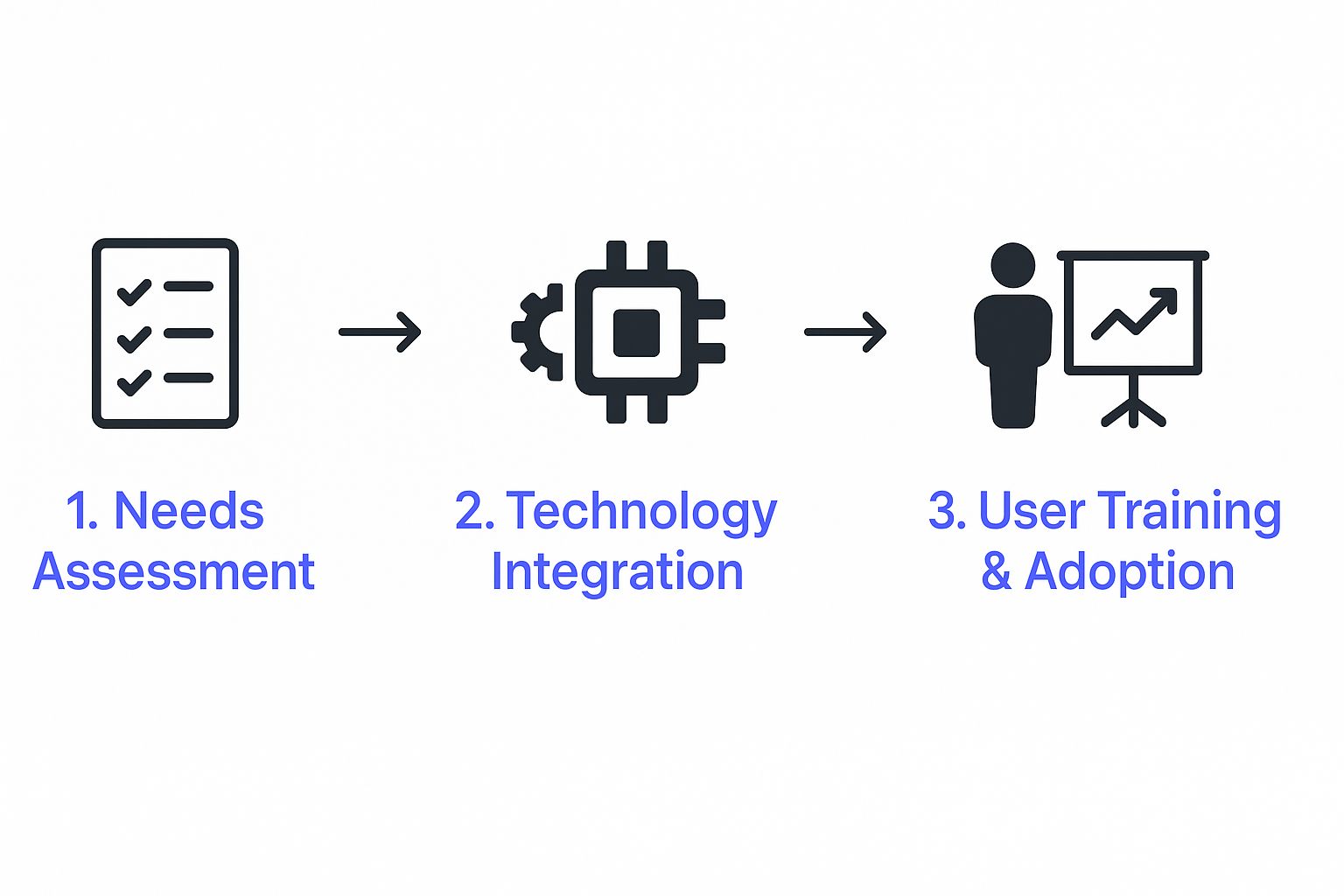
Let's be clear: legal digital transformation isn't about buying a few new software licenses and calling it a day. Think of it as a complete overhaul of your firm's engine—swapping out a clunky, paper-based system for a smart, interconnected digital command center. It's a fundamental shift in how your firm works, serves clients, and ultimately, creates value.
What Legal Digital Transformation Really Means

At its heart, legal digital transformation is about weaving technology into the very fabric of how you deliver legal services. It’s about taking a hard look at your existing processes and reimagining them to be more nimble, data-informed, and completely focused on the client. This evolution pulls a practice away from the swamp of manual tasks and into a world of efficient, automated workflows.
This kind of strategic change touches everything. It’s a top-to-bottom reimagining that paves the way for a more secure and profitable practice, impacting core functions like:
- Client Intake and Onboarding: Moving from stacks of paper to automated forms that capture client information seamlessly.
- Case and Matter Management: Using a single, central hub to track every deadline, document, and communication—no more lost files or missed dates.
- Legal Research and Analysis: Harnessing AI to unearth precedents and critical insights in minutes, a task that used to take days.
- Billing and Invoicing: Implementing automated systems that slash errors, speed up payments, and give you a clearer picture of your cash flow.
Moving Beyond Just Buying Tech
Real transformation goes much deeper than simply adopting new tools. It requires a cultural shift where technology becomes a core part of your firm’s strategy and daily rhythm. It’s about building a mindset of continuous improvement and being open to new ways of working.
The goal isn't to turn your firm into a tech company; it's to become a better law firm by using technology smartly. The real win is freeing up your legal professionals to focus on the high-value work only they can do—delivering strategic counsel, building client relationships, and solving complex problems.
This shift isn't just an internal push for efficiency, either. It’s a direct response to what clients now expect. They’re used to seamless digital experiences in every other part of their lives, and they demand the same from their legal team. They want transparency, faster communication, and predictable costs—all things a solid digital strategy delivers.
The momentum here is undeniable. The global legal technology market is projected to skyrocket to USD 46.76 billion by 2030, growing at a compound annual growth rate of 10.2%. This surge is driven by the growing demand for legal services that are both strategic and tech-powered. You can dive into the specifics by checking out the global legal tech market trends from GlobeNewswire.
The Core Pillars of Legal Digital Transformation
A successful transformation initiative isn't a single project; it's built on several interconnected pillars. These components work together to bring a practice into the modern era, and understanding them helps clarify what a comprehensive strategy actually looks like.
This table breaks down the key components, showing how each one contributes to modernizing a legal practice.
| Pillar | Description | Example Technology |
|---|---|---|
| Process Automation | Automating repetitive, rule-based tasks to boost efficiency and cut down on human error. | Document automation, automated billing, and e-discovery tools. |
| Data-Driven Decision Making | Using analytics to guide strategy, predict case outcomes, and manage the firm’s performance. | Practice management dashboards and predictive analytics software. |
| Enhanced Client Experience | Offering modern, digital channels for communication, collaboration, and service delivery. | Secure client portals and automated status update systems. |
| Operational Agility | Adopting flexible, cloud-based systems that enable remote work and seamless team collaboration. | Cloud-based practice management systems and virtual meeting platforms. |
By focusing on these core pillars, firms can build a robust foundation for change that delivers real, measurable results—not just a collection of new apps. It's about creating a smarter, more resilient practice ready for the future.
Key Technologies Driving Change in The Legal Sector

The engine behind this shift in the legal world isn't just one single invention. It’s a powerful combination of connected technologies that are already changing how legal work gets done. These aren’t some far-off concepts; they are practical tools being put to use today.
Think of these technologies as a coordinated team. Cloud computing is the secure, accessible foundation. Automation is the tireless assistant handling all the repetitive work. And artificial intelligence acts as the expert analyst, digging up insights you could never find on your own.
Together, they create a system that empowers legal professionals, not replaces them. This frees them up to focus on what really matters: strategic advice, complex negotiations, and building strong client relationships. Let's break down each of these core components.
Artificial Intelligence and Machine Learning
Artificial intelligence (AI) is often misunderstood. In the legal field, it’s not a single, all-knowing brain. It’s more like a team of highly specialized assistants, each trained for a specific task. AI algorithms can review and analyze huge amounts of information at a speed and scale no human could ever match.
Take e-discovery, for example. AI can sift through millions of documents, emails, and files to pinpoint relevant evidence in a tiny fraction of the time it would take a team of paralegals. This is a complete game-changer for litigation, drastically cutting costs and speeding up case timelines. Some firms are even using predictive analytics to forecast case outcomes based on historical data, which helps shape strategy and settlement talks.
A recent PwC survey found that 73% of U.S. companies have already adopted AI in some form. The legal sector is catching up, realizing that AI isn't here to replace lawyers but to supercharge their abilities with better, data-backed insights.
Automation for Repetitive Tasks
While AI handles the heavy-duty analysis, automation is the workhorse focused on pure efficiency. Tools like Robotic Process Automation (RPA) are designed to take over the rule-based, repetitive tasks that eat up so much of a firm's valuable time.
This technology is perfect for any job that follows a predictable pattern. Just look at these common uses:
- Contract Management: Automation can instantly flag non-standard clauses, track renewal dates, and send out alerts so nothing ever falls through the cracks.
- Client Intake: Automated workflows can guide new clients through the onboarding process, collect all the necessary information, and generate engagement letters without anyone lifting a finger.
- Scheduling and Reminders: Systems can automatically schedule depositions and meetings, check everyone's calendars, and send reminders to all parties involved.
One UK law firm reported an incredible 80% improvement in its contract review time just by implementing an AI-powered automation tool. By offloading these essential but time-sucking tasks, automation frees up legal professionals to focus on high-value work that requires real human brainpower.
Cloud Computing as The Foundation
If AI and automation are the high-tech tools, cloud computing is the modern workshop where everything happens. Cloud-based platforms provide the secure, centralized, and accessible infrastructure that’s absolutely essential for any real digital shift in a legal practice.
Gone are the days of being chained to a server in the office. With the cloud, your firm’s data—case files, documents, billing info—is stored securely online. This unlocks several key advantages:
- Anywhere Access: Lawyers and staff can pull up critical information from any location with an internet connection. This makes remote work a breeze and boosts productivity on the go.
- Enhanced Security: Top cloud providers invest a fortune in security measures like encryption and threat detection, often offering protection that’s far beyond what a single firm could manage on its own.
- Seamless Collaboration: Teams can work on the same documents in real-time, and secure client portals allow for transparent communication and file sharing, which builds stronger client relationships.
Ultimately, the cloud is the foundational layer that makes everything else possible. It breaks down information silos and creates a single source of truth for the entire firm, ensuring everyone is on the same page.
The Undeniable Benefits of Embracing Legal Tech
Bringing new technology into a law firm is about so much more than just doing old things faster. When you fully commit to a legal digital transformation, you’re actually reshaping your entire practice into a more efficient, profitable, and client-friendly operation. The positive effects ripple through everything you do, from day-to-day tasks to your firm's bottom line.
Think of it as gaining a serious competitive edge. It’s the difference between being reactive and buried in paperwork versus being proactive and guided by real data. This isn't about just keeping up; it’s about leading the pack in a market where clients expect modern, transparent service.
Sharpening Strategy with Data-Driven Decisions
One of the biggest game-changers legal tech offers is the power to make decisions based on cold, hard data instead of just gut feelings. Modern practice management systems with built-in analytics give you a real-time dashboard of your firm's health, showing you exactly what’s working and what’s not.
With the right tools, you can easily track key performance indicators (KPIs) that matter, such as:
- Case Profitability: Finally understand which case types bring in the most money, so you can focus your resources where they count.
- Attorney Performance: Get a clear picture of billable hours, who’s overworked, and who has capacity, letting you optimize your team’s performance.
- Client Acquisition Costs: Analyze where your best clients are coming from and what it costs to land them, so you can stop wasting money on marketing that doesn’t work.
This data-first approach takes the guesswork out of running your firm. Instead of making strategic bets in the dark, you can use actual evidence to steer growth, fix operational bottlenecks, and build a much more resilient business.
Boosting Profitability Through Optimized Workflows
Every minute your team spends on repetitive admin work is a minute they aren't billing or providing strategic advice. Digital transformation tackles this head-on by automating the routine tasks that drain your resources and open the door to human error.
Take automated billing and invoicing. These systems get rid of the soul-crushing, error-prone chore of manual time entry and invoice creation. Not only does this save a ton of hours, but it also improves accuracy, which means you get paid faster and your cash flow improves. A central document system is another perfect example—it ends version-control nightmares and stops people from wasting time hunting for the right file. For more on that, our guide on small business document management offers some great, practical solutions.
By streamlining core operations—from the moment a client walks in the door to the final bill—firms can slash their overhead. That saved time and money can be poured back into high-value activities that actually grow the business.
Enhancing The Client Experience
Your clients now expect the same slick, digital experience from their law firm that they get from Amazon or their bank. Technology gives you the power to not only meet but exceed those expectations, building much stronger and more loyal relationships.
Secure client portals, for example, give clients a clear window into their case. They can log in whenever they want to see documents, check on progress, and send secure messages. This simple self-service feature cuts down on the constant "just checking in" calls and emails, freeing up your team while keeping clients happy and in the loop. Automated reminders and updates also ensure they never feel forgotten or miss an important deadline.
This level of transparency isn't a luxury anymore; it's a key differentiator. The American Bar Association’s research shows just how digital the profession has become. In a recent survey, 67% of attorneys said they use paid online legal research tools, and 55% use free ones, proving how deeply we now rely on digital methods. You can see the full breakdown in the ABA’s latest report on legal tech trends. Adopting these tools is simply essential for meeting the demands of the modern client.
Navigating The Challenges Of Digital Implementation

While the benefits of going digital are easy to see, the path to get there is rarely a straight line. Let's be honest: shifting to a modern, tech-driven practice comes with real-world obstacles. The first step to clearing these hurdles is to acknowledge them head-on.
Most firms run into the same three roadblocks: the cost of new tech, getting the team on board, and navigating the maze of security and compliance rules. Each one is a challenge, but none are impossible to overcome with the right game plan.
Managing High Implementation Costs
The sticker shock from new legal software can stop a digital transformation in its tracks, especially for smaller firms. There's a common fear that you need a massive, upfront investment that drains the budget before you see any benefit. But that all-or-nothing mindset is a myth.
A much smarter approach is a phased rollout. Instead of trying to fix everything at once, find your single biggest pain point. Is it chaotic document management? A clunky client intake process? Start there with one affordable, targeted solution. This lets you prove the value quickly, score an early win, and build a strong case for future investments.
By focusing on high-impact areas first, you create a ripple effect. The efficiency gains from one successful project can help fund the next phase, turning digital transformation into a self-sustaining cycle of improvement rather than a one-time budget-breaker.
Many modern legal tech companies also offer subscription-based models (SaaS), which swap a huge one-time expense for a predictable monthly operating cost. This makes powerful tools accessible without breaking the bank.
Overcoming Cultural Resistance And Fostering Adoption
Honestly, the biggest hurdle often isn't the technology—it's the people. Attorneys and staff get comfortable with their routines. Introducing a new system can be met with skepticism or even outright resistance, which can slow down or completely derail the whole project.
The secret to getting everyone on board is to focus on the benefits, not the features. Don't just announce new software; show your team how it gets rid of a tedious task they all hate or gives them an edge in winning cases. You have to answer the "What's in it for me?" question.
A few strategies work wonders for driving adoption:
- Appoint Tech Champions: Find respected team members who are genuinely excited about the new tools. Empower them to lead by example and help their colleagues get up to speed.
- Provide Targeted Training: Forget generic, one-size-fits-all training. Offer role-specific sessions that show each person exactly how the tech makes their daily job easier.
- Celebrate Small Wins: When a team or individual masters a new system, acknowledge it publicly. Positive reinforcement goes a long way.
When you make the transition a team effort, you can turn skeptics into your biggest supporters. One of the best ways to smooth out this process is to introduce tools that make complex tasks simpler. You can learn more in our guide on legal workflow automation to see how these systems can make everyone's life easier.
Navigating Cybersecurity And Data Privacy
Law firms are guardians of incredibly sensitive client information, which makes data security an absolute top priority. Moving to digital platforms, especially cloud-based ones, naturally raises concerns about confidentiality and cyberattacks. These aren't risks you can afford to ignore.
A core part of any digital transformation is navigating the complex web of security regulations. This is especially true as laws evolve to keep up with technology. For example, a recent survey on Australian legal tech benchmarks and trends showed that cybersecurity is a top concern, as firms work to comply with new privacy and security acts. This isn't just an Australian issue; it's a global reality.
The key to managing these risks is to vet your tech vendors meticulously. Look for providers with rock-solid security credentials like SOC 2 compliance, end-to-end encryption, and regular third-party security audits. A reputable vendor’s security setup is almost always more robust than what a single firm could build and maintain on its own.
While the journey has its share of obstacles, a clear strategy can turn potential roadblocks into stepping stones. The table below breaks down these common challenges and offers actionable solutions to keep your firm’s digital transformation on track.
Common Challenges and Strategic Solutions
| Challenge | Primary Risk | Strategic Solution |
|---|---|---|
| High Upfront Costs | Budget overruns and a negative return on investment before benefits are realized. | Implement a phased rollout, starting with high-impact, low-cost solutions. Opt for SaaS models with predictable monthly fees. |
| Cultural Resistance | Low user adoption, which undermines the entire project and wastes the investment. | Focus on "What's in it for me?" by demonstrating clear benefits. Appoint tech champions and provide role-specific training. |
| Cybersecurity Concerns | Data breaches, loss of client trust, and non-compliance with privacy regulations. | Prioritize vendors with strong security credentials (e.g., SOC 2, encryption). Implement strict internal data policies and training. |
With a proactive approach, these challenges become manageable parts of a larger strategy. By anticipating costs, engaging your team, and prioritizing security, you can ensure your firm's digital transformation is a success.
Your Practical Roadmap for Firm Transformation
Jumping into a full-scale digital overhaul can feel like you're trying to boil the ocean. It's a massive undertaking. But the journey gets a lot clearer—and less intimidating—when you have a practical map to follow. This roadmap breaks the process down into logical phases, turning a huge concept into a manageable project.
This isn't about flipping a switch and changing everything overnight. It's about taking deliberate, smart steps to build a more efficient, resilient, and client-focused practice. A structured plan is your best bet to ensure your investments in new tech actually deliver real, measurable value.
The whole process boils down to three main stages: understanding where you are, bringing in the right technology, and making sure your team actually uses it.
This visual gives you a simple, at-a-glance look at the core workflow.

As the infographic shows, a successful transformation is a series of deliberate steps, not a single event. It starts with a deep dive into your current processes, moves to careful implementation, and is kept alive by ongoing support and training for your team.
Phase 1: Assess Your Current State and Define Success
Before you even think about shopping for software, you need to take an honest look at where your firm stands right now. A successful legal digital transformation always begins with a clear-eyed assessment of your current tech and daily routines.
Start by mapping out your core workflows. How do you actually handle client intake, manage documents, send out bills, and track cases? Pinpoint the bottlenecks, the soul-crushing manual tasks, and the spots where mistakes tend to happen. A staggering 91% of legal professionals see this kind of modernization as critical, mostly because they're buried under administrative work.
Once you know your pain points, you can define what "success" actually looks like for you. Your goals need to be specific and measurable. Don’t just aim for “better efficiency.” Set a concrete goal like, “cut document drafting time by 20%” or “slash invoice errors by 90%.”
This initial assessment is the most important phase. If you don't have a firm grasp of your problems and a clear definition of your goals, you'll end up investing in technology that solves the wrong issues—or delivers no real return at all.
Phase 2: Choose the Right Tools and Launch a Pilot
With your needs clearly defined, you can start looking at technology that will get you to your goals. This isn't about chasing shiny new objects; it's about finding the right tools for your firm’s specific headaches. Zero in on solutions that play well together and directly tackle your biggest pain points.
Key technologies to look into often include:
- Practice Management Systems to bring case information, time tracking, and client data into one central hub.
- Document Automation and Management to create consistent documents and finally end the chaos of version control. For a deeper dive, check out our guide on best practices for legal document management.
- Legal Billing Software to automate invoicing, track payments, and get a better handle on your firm’s cash flow.
Instead of trying to roll everything out to the entire firm at once, start with a pilot program. Pick a small, motivated team to test the new tech on a single project. This approach is much lower-risk and lets you gather incredibly valuable feedback. It’s the perfect way to work out the kinks and create a success story that inspires everyone else.
Phase 3: Manage Change and Measure Your ROI
The final phase is all about your people and the results. Buying new software is only half the job. Getting your team to actually embrace it is what makes or breaks the entire effort. This requires a solid change management plan.
Provide thorough, role-specific training. Your team needs to understand not just how to use the new tool, but why it makes their jobs easier. Foster a culture that values digital skills and appoint a few internal "tech champions" who can help their colleagues get up to speed.
Finally, you have to measure your return on investment (ROI). Go back to those specific goals you set in Phase 1. Did you actually reduce document drafting time? Are your invoices more accurate? Use the data from your new systems to track these key metrics.
Showing a clear, positive ROI is non-negotiable. It proves the value of what you’ve done, justifies spending more in the future, and cements technology's role as a core part of your firm’s growth. Transformation is never truly "done," and measuring your success is what ensures you keep adapting and improving.
Answering Your Key Questions
Stepping into a full-scale digital shift can bring up a lot of valid questions. Firm leaders, especially those balancing tight budgets and long-standing traditions, often wonder where to start, what to prioritize, and how to handle the inevitable bumps in the road.
This section tackles the most common questions we hear about legal digital transformation head-on. No jargon, just straightforward answers to help you move forward with clarity and confidence.
How Do We Start If Our Budget Is Limited?
This is probably the most frequent question we get, and the answer is reassuring: you don't need a massive, upfront investment to get started. The very idea of "digital transformation" can conjure images of eye-watering invoices and firm-wide overhauls, but the reality is much more strategic and budget-friendly.
The key is to think small to win big.
Start with a focused pilot project. Pinpoint the single biggest source of inefficiency or frustration in your firm. Is it a chaotic document management process? Is client intake slow and clunky? Pick that one high-impact area and find a targeted solution to fix it. Starting small contains both the risk and the cost.
Many modern legal tech tools operate on a subscription (SaaS) model. This turns a huge capital expenditure into a predictable monthly operating expense, making powerful software far more accessible. You pay as you go, and you only scale up your investment after you’ve seen a tangible return. A successful pilot creates undeniable proof of value, building the momentum and internal buy-in you need to justify bigger projects down the road.
What Is The Single Most Important Technology For A Small Firm?
With so many options out there, it’s easy to get overwhelmed. For most small to mid-sized firms, the one piece of tech that delivers the most immediate and widespread impact is a cloud-based legal practice management system (LPMS).
Think of it as the central nervous system for your entire practice.
An LPMS is so crucial because it solves multiple problems at once. Instead of juggling a patchwork of separate tools for different jobs, a good system will bring all your core functions under one roof:
- Case and matter information
- Document management and storage
- Time tracking and billing
- Client communication and portals
- Calendaring and deadline tracking
By centralizing everything, you create a single source of truth for your firm. This instantly improves organization, slashes the risk of human error, and gives everyone the information they need, right when they need it. It’s the solid foundation you can build all your other digital initiatives on top of.
How Do We Get Senior Partners On Board?
Resistance from senior partners or long-tenured staff is a classic hurdle. They're often comfortable with the old ways of doing things and might be skeptical of new technology. The trick to winning them over is to stop talking about technology and start talking about outcomes.
Frame the change around their specific goals and pain points.
Instead of rambling on about software features, focus on the answer to their unspoken question: "What's in it for me?" Show them precisely how a new system can eliminate the administrative headaches they despise, automate tedious tasks, or surface data that helps them build stronger cases and win more clients.
Demonstrate clear, personal benefits. For instance, show a litigator how a tool can analyze thousands of discovery documents in hours, not weeks. Show a managing partner a dashboard that gives them an instant, real-time snapshot of firm profitability.
Appointing a respected senior partner as a "champion" for the project can also be incredibly effective. Their endorsement lends the project credibility and encourages others to get on board. When you combine that with hands-on, role-specific training, you can turn skeptics into your biggest advocates.
Is Our Firm And Client Data Truly Secure In The Cloud?
This is a non-negotiable concern, and for good reason. Law firms are custodians of incredibly sensitive information. But the old notion that on-premise servers are automatically more secure than the cloud is largely outdated.
In reality, reputable, legal-specific cloud providers offer a level of security that most individual firms simply can't afford to build and maintain on their own.
When vetting vendors, due diligence is everything. Look for these key security credentials and practices as a baseline for trust:
- SOC 2 Compliance: This is an auditing procedure that ensures a vendor securely manages data to protect the interests and privacy of its clients. It's a huge green flag.
- End-to-End Data Encryption: This means your data is scrambled and unreadable both while it's being transferred and while it's sitting on their servers.
- Regular Third-Party Audits: The best providers hire independent security firms to constantly test their systems, find vulnerabilities, and fix them.
For these companies, security is their business model. They invest millions in infrastructure, threat detection, and expert personnel to do one thing: keep your data safe.
Ready to demystify your legal documents without the high cost of consultations? At Legal Document Simplifier, we offer an AI-powered platform that transforms dense contracts into clear, actionable summaries. Upload your document and get instant insights into key terms, deadlines, and potential risks. Discover a smarter way to handle legal paperwork at https://legaldocumentsimplifier.com.